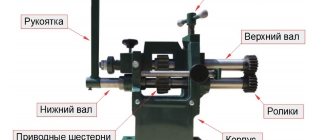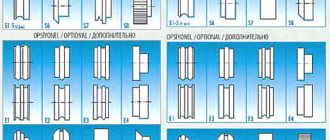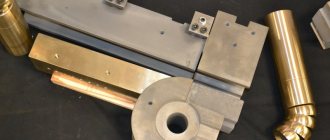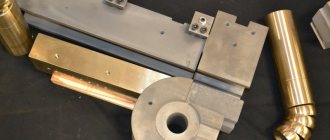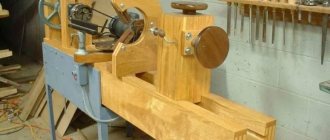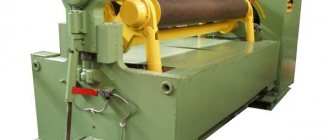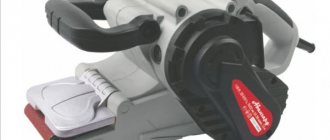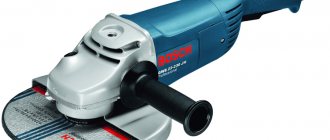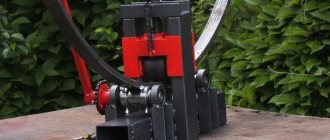Manual seaming machine, classification of rollers and homemade drawings
The creasing machine is used in tin work for joining cylindrical parts, flanging edges and rolling ribs. This is a mandatory stage in the processing of sheet metal products, so the characteristics of crimping must be approached carefully. The executive tool of the zig machine is rolling rollers of various profiles. Each type of roller is designed to perform a specific job. In production, the machine works in conjunction with a folding bender, a guillotine, folding equipment and rollers.
Rollers for creasing machines
/CROSSING MACHINES /rollers for creasing machines
-
-
-
-
-
-
-
-
-
-
-
-
-
-
-
-
-
-
-
-
-
-
-
-
-
-
-
-
-
-
www.25mm.ru
Purpose and design of beading equipment
Before you begin to understand what a crimping machine is, you need to understand why creasing is performed. In the process of carrying out this technological operation, recesses of a semicircular profile are applied to the surface of the sheet metal workpiece. Such recesses, which are called ridges, act as stiffening ribs; their presence on the surface of a thin-walled metal product makes it much stronger. The size of the recesses, for the formation of which the zig machine is used, completely depends on the thickness of the metal used for the workpiece. To select this parameter, which is very important for such a technological operation, special lookup tables are used.
Many modern manufacturers produce crimping machines, the technical capabilities of which allow them to perform a whole range of technological operations. The operations to which sheet metal blanks are subjected during their circular processing include corrugating their surface, cutting and flanging. More powerful and productive, when compared with manual equipment, are electric crimping machines. Due to the presence of a powerful electric drive in their design, such machines make it possible to successfully process workpieces made of thicker sheet metal.
Main parts of the seaming machine
Regardless of whether the crimping machine is equipped with a manual or electric drive, the design and operating principle of such a machine remain virtually unchanged. The main design elements of such machines are two shafts, the axes of which can be located horizontally or at some angle. It is these shafts, rotating relative to each other in the opposite direction, that impart rotation to the working rollers fixed at their end part. The zig machine works, both manual and electric, according to the following scheme:
- the sheet metal blank is placed between two forming rollers of the equipment;
- the machine shafts are brought together, thereby ensuring clamping of the workpiece between the working rollers;
- using a manual or electric drive, the shafts are rotated;
- when the shafts and working rollers rotate, the part sandwiched between them also begins to move; When a workpiece is moved between working rollers with protrusions of the required size and shape, corresponding depressions are formed on the surface of the sheet metal under the influence of plastic deformation.
Areas of application for creasing equipment
Equipment designed to perform beading, even though the name of such a technological operation is familiar mainly to metalworking specialists, is actively used in various fields of activity. Sealing machines are practically indispensable for the manufacture of elements of roofing structures, in particular, for the formation of their edges.
Examples of drainage elements made on a crimping machine
It should be noted that in the construction industry, bending machines have found very wide application. Using such machines, in particular, the following elements of building structures and communication systems are made from sheet metal: parts of drainage and air duct systems, insulation for heating mains, etc. In the construction industry, manual staking equipment is predominantly used, since it is characterized by its small dimensions and insignificant weight, does not require an electrical supply for its operation and can be used almost anywhere.
The creasing machine can also be used to reliably connect cylindrical workpieces made of thin sheet metal together. Rollers for equipping a zig machine of this type, when a cylindrical workpiece passes through them, form locks on it, with the help of which the two parts are connected.
Rolling the lock on the air duct elbow
When making connections using locks, unlike welding, there is no thermal effect on the metal parts, which eliminates the possibility of their warping. In addition, such a machine, which you can also make yourself, does not require any additional consumables for its use.
To expand the functionality of a staking machine, including a manual one, it can be equipped with additional working parts. Machines equipped in this way can be used not only as creasing equipment, but also as bending and profiling equipment. Modern creasing machines for industrial use are often equipped with automated control systems, which increases their productivity and accuracy of technological operations performed with their help.
Special attachments allow you to make folds for connecting thin-walled pipes
Design Features
The classic design has the following features:
- The main structural element can be called a combination of two plates. Many manufacturers create these plates using the waterjet cutting method. The method under consideration has high accuracy.
- In the formed space between the two plates there are two shafts, which are the main elements in contact with the workpiece.
- Of the two installed shafts, the upper one is movable. Its movement occurs due to a special screw-type clamp. Note that a high-quality homemade zigging machine should have a uniform effect on the entire workpiece, since only in this case a high-quality zigging is obtained.
- The main parameter that can be set using the control unit, manual or automatic, is the zigging depth.
The shape of the ridge can be different, depending on the type of installed rollers. Therefore, when creating a crimping machine with your own hands, you should provide for the possibility of replacing the rollers.
Rollers of creasing machines
DIY SIG machine
This SIG machine was developed by the author of the YouTube channel “Nikolai Chernak”. It is based on 2 shafts with a diameter of 35 mm. Installed in bearing housings. The lower shaft is stationary, the housings are tightly welded to the racks, and the upper shaft is movable - it rises up quite high. But you don’t need to lift it like that - it’s convenient until the engagement teeth come out.
When planning, it was taken into account that the axis of rotation is closer to the teeth - but not too much. Because if you place it closer, the body gets stuck. Therefore, it is designed like this: closer to the teeth, at the same time on the edge of the body, so when opening, nothing interferes with anyone.
A gear wheel is used at the rear - a gear pair - it was taken ready-made from the wheel beading mechanism. Previously, during the Soviet Union, kits for passenger cars were sold - trimming, disassembling wheels. I took a gear from it. The gear ratio turned out to be good - easy to rotate.
The steering rod of the car is used in the mechanism for opening the impellers. Convenient – ready-made hinge, just welded, that’s it. Let's weld the screw on the hinge to avoid a break here. The handle is also made by hand from old car parts; at the end there are balls from steering tips. There is a part feed limiter, i.e. letting the lambs in, you can use it. Parts from shock absorbers were used. Hub of a Minsk motorcycle. To avoid sharpening, motorcycle parts are often used.
The working rollers are made to be removed separately from the hubs. If you unscrew the three screws, the upper part of the impeller is removed. And the hub always remains screwed on. But it has movement along the key. There is a corkscrew. As a result, there is no need for very thick blanks during the production of new rollers. Having narrow workpieces on this ZIG machine, you can grind rollers of different configurations.
How to operate a zig machine
Once the above device has been purchased or designed, you can begin metal processing. The machine is easy to use, but there are important nuances that are worth talking about additionally:
- The workpiece must be additionally secured using a special stop. The degree of fixation is adjusted using the appropriate screws.
- The leading edge of the workpiece should be inserted between the rollers of the machine.
- The second roller of the machine is controlled by a handle.
- The rollers are driven using a special handle (in manual machines).
Several cycles may be required to fully process a part. After the required result is achieved, the workpiece can be removed and the working units of the machine.
Application area
Most often, crimping machines are used in the construction industry. Using such a device, it is possible to produce a whole range of simply irreplaceable structures: elements of air duct systems, drainpipes, spare parts for heating mains. In this field of activity, manual creasing machines are mainly used. They are relatively cheap and have small dimensions. In addition, you do not need to supply electricity to use them.
Crimping machines are often used to process cylindrical parts. The rollers of such a machine, while passing through the cylinder, make special locks on it, to which other parts are attached. This processing method has less negative impact on the workpiece than the welding process. Another advantage of the zig machine is the lack of need for additional consumables.
Types of rollers for zig machines
rollers for zigging machine
Manufacturers can change the labeling of the rollers they produce; here are the most common names.
- V - for decorating the edges of insulating boxes and pipes, rolling wire using ZB ZA;
- S - for the production of stopper ridges and stiffeners;
- SK - for making ribs of rectangular section. Wide ribs are used to fix rubber seals in the manufacture of round-section ventilation ducts;
- E, EV - the edges of the pipes are corrugated, making the diameter smaller for socket connections. Used for the manufacture of ventilation and drainage pipes and chimneys. EV rollers perform both stop rib and corrugation;
- BC - bend the edges on flat-shaped parts for flanging elements of rectangular air ducts, used in the manufacture of round-shaped plugs;
- KA - the set includes four rollers (two pairs) for connecting round pipes with further spot welding. They make connections with an overlap of 8 to 12 mm, and are used in the manufacture of small series of air ducts and chimneys;
- BS, F - make a double fold of a vertical lock with a flanging height from 4 to 12 mm, it is selected taking into account the thickness of the material;
- BB - performing flanging of the edges of mortises of various shapes, including tees, as well as for bending the short fold of a vertical lock;
- KB - upsetting of a vertical lock. Lock folds are made on rollers BB, BS and F. They are used to connect branches and transitions of vertical folds, parts of weirs and air vents;
- BD - perform flanging of the edges of long round pipes;
- ZB, ZA - roll wire along the edge of the pipe. The edge is first bent on V rollers. This procedure is necessary to increase the rigidity of pipes made from thin sheets of metal; it is performed exclusively on zig machines;
- AV - coupling of inserts into ventilation blanks using a screw method, ensures tightness;
- DIN 71550 - makes semicircular ribs on pipe blanks of small diameters for attaching a flexible hose. The minimum diameter of the pipe is 1 cm, it works on any type of metal. This type of roller is not compatible with all types of equipment;
- M - cut pipe blanks across the diameter. Complete with a holder, it cuts out rings from sheets.
In order for a beading machine to perform quality cuts, it must be equipped with a parallel roller clamp. The semicircular stop is an addition to the BB rollers. It is used for external flanging in round cutouts of flat parts.
Purpose of crimping machines
Before creating a machine with your own hands, you should pay attention to its purpose, as this determines the design features. A seaming machine is used to connect parts that are made using metal with a thickness of 0.5 - 4 millimeters. The production process is as follows:
- The first stage is represented by the creation of the castle.
- Once the lock is created, the force generated by the machine allows the parts to be connected.
A homemade zig machine can be used to solve the following problems:
- Production of pipes and other sheet metal products.
- When carrying out roofing work.
- During work on thermal insulation of pipes.
You can use your machine for flanging, corrugating and zigging.
Quite often you can come across the question - how does this processing method differ, for example, from welding. The main difference is that welding is exposed to high temperatures, as a result of which internal stresses and deformations arise, and the performance properties of the material change significantly. At the same time, the connection obtained by welding has a strength much lower than that obtained by creasing.
Equipment for zig machines EVOLUTIONER™
The kit includes four types of rollers: corrugating, flanging and two pairs of rollers for making a prefabricated elbow. In some cases, a zig machine can be equipped with knives for cutting curved surfaces. Knives must be ordered separately.
Sometimes, for their work, tinsmiths require non-standard rollers for zig machines , which are manufactured by us according to the customer’s sketches. If you have a zigging machine and it is not of our production, then, if necessary, we can make rollers for you according to your sketches for your zigging machine.
The standard kit also includes a wrench for tightening the rollers on the shaft.
By purchasing zig machines from the manufacturer EVOLUTIONER™ you save your time and money!
Technical characteristics of zig machines
Sealing machines are characterized by the following main parameters.
| Characteristic | Meaning |
| Drive type | manual, electromechanical, hydraulic |
| Roller diameter | can be from 50 to mm |
| Roller overhang | up to 350 mm is an important indicator; when performing special work, the maximum reach of the shoulders is selected |
| Number of additional pairs of rollers | usually 4 to 6 pairs |
| Metal thickness | from 0.5 to 4 mm |
| Machine dimensions | even hydraulic zigovkas take up little space |
| Machine weight | from 17 to 300 kg |
Table 1. Some characteristics of crimping machines
